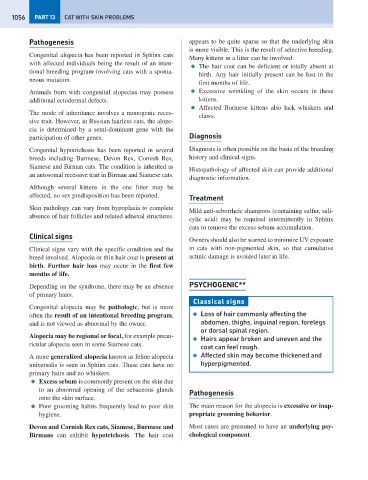Page 1064 - Problem-Based Feline Medicine
P. 1064
1056 PART 13 CAT WITH SKIN PROBLEMS
Pathogenesis appears to be quite sparse so that the underlying skin
is more visible. This is the result of selective breeding.
Congenital alopecia has been reported in Sphinx cats
Many kittens in a litter can be involved.
with affected individuals being the result of an inten-
● The hair coat can be deficient or totally absent at
tional breeding program involving cats with a sponta-
birth. Any hair initially present can be lost in the
neous mutation.
first months of life.
Animals born with congenital alopecias may possess ● Excessive wrinkling of the skin occurs in these
additional ectodermal defects. kittens.
● Affected Burmese kittens also lack whiskers and
The mode of inheritance involves a monogenic reces-
claws.
sive trait. However, in Russian hairless cats, the alope-
cia is determined by a semi-dominant gene with the
participation of other genes. Diagnosis
Congenital hypotrichosis has been reported in several Diagnosis is often possible on the basis of the breeding
breeds including Burmese, Devon Rex, Cornish Rex, history and clinical signs.
Siamese and Birman cats. The condition is inherited as
Histopathology of affected skin can provide additional
an autosomal recessive trait in Birman and Siamese cats.
diagnostic information.
Although several kittens in the one litter may be
affected, no sex predisposition has been reported. Treatment
Skin pathology can vary from hypoplasia to complete
Mild anti-seborrheic shampoos (containing sulfur, sali-
absence of hair follicles and related adnexal structures.
cylic acid) may be required intermittently in Sphinx
cats to remove the excess sebum accumulation.
Clinical signs
Owners should also be warned to minimize UV exposure
Clinical signs vary with the specific condition and the in cats with non-pigmented skin, so that cumulative
breed involved. Alopecia or thin hair coat is present at actinic damage is avoided later in life.
birth. Further hair loss may occur in the first few
months of life.
Depending on the syndrome, there may be an absence PSYCHOGENIC**
of primary hairs.
Classical signs
Congenital alopecia may be pathologic, but is more
often the result of an intentional breeding program, ● Loss of hair commonly affecting the
and is not viewed as abnormal by the owner. abdomen, thighs, inguinal region, forelegs
or dorsal spinal region.
Alopecia may be regional or focal, for example preau-
● Hairs appear broken and uneven and the
ricular alopecia seen in some Siamese cats.
coat can feel rough.
A more generalized alopecia known as feline alopecia ● Affected skin may become thickened and
universalis is seen in Sphinx cats. These cats have no hyperpigmented.
primary hairs and no whiskers.
● Excess sebum is commonly present on the skin due
to an abnormal opening of the sebaceous glands Pathogenesis
onto the skin surface.
● Poor grooming habits frequently lead to poor skin The main reason for the alopecia is excessive or inap-
hygiene. propriate grooming behavior.
Devon and Cornish Rex cats, Siamese, Burmese and Most cases are presumed to have an underlying psy-
Birmans can exhibit hypotrichosis. The hair coat chological component.

